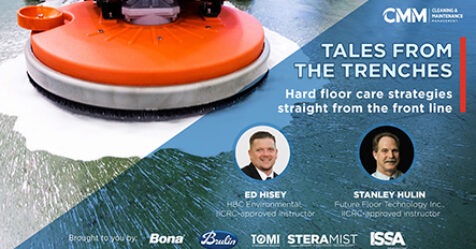It is no secret to anyone in the professional cleaning industry that cleaning budgets, especially for educational facilities, have been cut dramatically.
While there appears to be some improvement lately, with school districts allowing educational facilities to spend a bit more for cleaning and maintenance, like so many things that have changed since the “crash of 2007,” it is doubtful that schools will be spending the same amount of money on cleaning and maintenance as they were a decade or so ago anytime soon.
This most specifically applies to floorcare.
Savings Prove Expensive
What we are witnessing in recent years is that managers are eliminating the practice of stripping and refinishing floors.
In most cases, they are doing this as a cost savings, and it must be admitted, floorcare maintenance is typically one of the most expensive maintenance services a facility encounters.
However, while the districts may save a few pennies now, the results of this change may prove expensive down the road.
A floor finish does more than put a shine on the floor; it protects the floor so that soils and grit are not pounded into the floor.
But as with so many expenditures when times are tight, many managers are focused on the here and now, no matter what the long-term costs may be.
It is important for managers and cleaning professionals, especially in school facilities, to know that they can reduce floorcare costs and still keep floors clean and shiny.
This first starts with an effective matting system at all entries, not just key entries.
Matting helps minimize the amount of soil entering the facility.
But as we shall see, automating floorcare is essential.
Again we bump into sticker shock, but managers must realize that if mopping a floor takes a custodial worker eight hours, in most cases, an automatic scrubber can reduce that to about one hour.
That is the “shock” they should focus on.
Further, the labor savings can pay for the machine in just months.
Low On Funds, More Data Needed
Other than matting and mechanizing floorcare, it is important to know exactly what you are dealing with in regards to floorcare needs.
Surprisingly, many facilities have little or no floorcare data available.
It all comes back to that old management adage, “You can’t manage what you can’t measure.”
Some of the floorcare data that should be considered mandatory includes the following:
- The specific amount of floor space that must be maintained
- The specific areas that must be maintained; some hard-surface floors in obscure areas of a facility may need little more than a dust mopping from time to time
- Equipment available to perform floorcare tasks, including mops, buckets and floorcare machines such as automatic scrubbers, low- and high-speed machines, and more
- The amount of chemical needed for each task; generally, 1 gallon of stripper can cover about 100 square feet and 1 gallon of floor finish may provide four or five coats to a 400-square-foot floor*
- Time required to do floorcare task
- Number of workers available
- Hourly wage paid to the workers.
The last three items are critical, and the more attention paid to these three, the greater the savings.
For example, let’s assume two custodians clean approximately 30,000 square feet of floor space five nights per week.
The tools they use, a mop and bucket, cost about $50; the custodians take nearly five hours each to mop this floor area on a set schedule.
Based on their wages, it costs this facility about $25,000 annually to perform this task.
Another facility cleans the same amount of floor space but uses an automatic scrubber.
The machine cost about $3,500, but it can clean about 8,500 square feet in an hour.
The total time to clean the 30,000 square feet is 3.5 hours nightly and requires just one custodial worker.
Total labor costs: $8,750 annually.
The automatic scrubber is paid for in less than three months.
Convincing The C-Suite
One of the big benefits of collecting floorcare data is that managers and custodial workers can use the data, especially as it pertains to costs and mechanizing floorcare, as a way to convince the C-suite that purchasing an automatic scrubber and automating floorcare will ultimately be a costs savings.
Instead of shouting “show me the money,” the famous line from the movie Jerry Maguire, managers and custodial workers can now proudly show the C-suite the savings.
While there can be many variables that ultimately impact floorcare costs, the more floorcare data managers and cleaning professionals have about the floors they maintain, the better they can be at finding floorcare savings.
In most cases, floors that are shiny not only protect the floor surface, but also improve the overall appearance of a facility and the mood of people using the facility.
With a little data and know-how, this can be less expensive than many initially think.
*These are ballpark estimates and can vary due to a number of factors.



